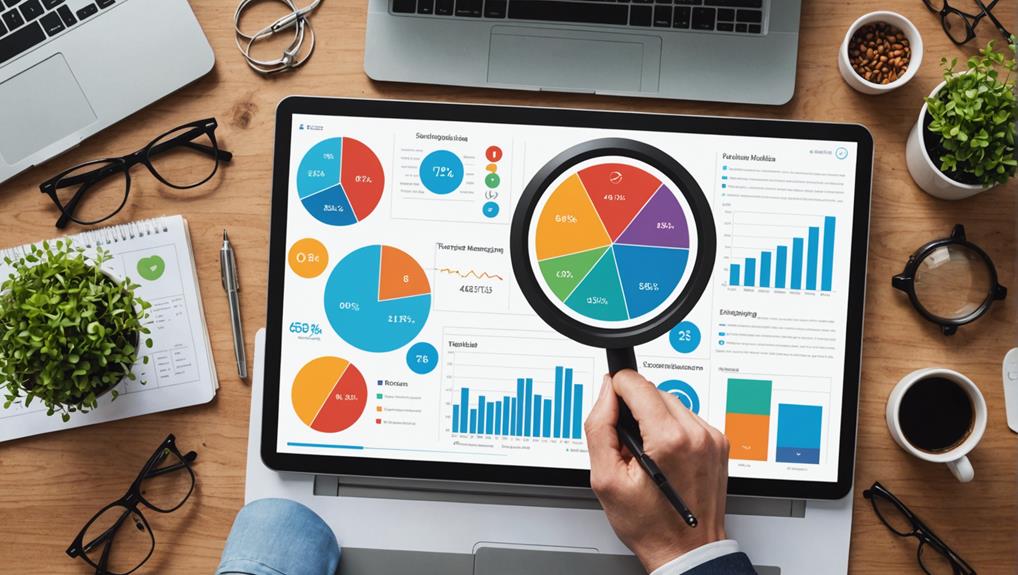Real-time analytics is vital for making data-driven decisions and improving operational efficiency. It provides immediate insights and supports personalized customer interactions. You'd benefit from tools like Apache Kafka for high-throughput, Amazon Kinesis for real-time streaming, or Google Cloud Dataflow for auto-scaling. In-memory processing speeds up data retrieval, while real-time visualization aids in interpreting complex datasets. However, be cautious of challenges like infrastructure limits and data accuracy. Overcoming these involves investing in scalable tools and robust training. Real-time analytics is essential in sectors such as healthcare, retail, and finance. Explore further to understand its profound impact on various industries.
Key Takeaways
- Real-time analytics enable data-driven decisions and operational efficiency.
- Apache Kafka and Amazon Kinesis are top tools for high-throughput data streaming.
- In-memory processing ensures quick data retrieval and real-time insights.
- Healthcare and financial sectors use real-time analytics for predictive insights and fraud detection.
- Scalability and training are essential to overcome infrastructure and implementation challenges.
Benefits of Real-Time Analytics
Real-time analytics empower businesses to make instant, data-driven decisions, enhancing operational efficiency and responsiveness to market dynamics. By processing data as it's collected, you can derive immediate insights, which are vital for making informed decisions swiftly. This immediate access to data helps in improved decision making, enabling you to respond to opportunities and threats faster than ever before.
Enhanced efficiency is another substantial benefit of real-time analytics. With real-time data, you can optimize various operational processes, such as resource allocation and supply chain management. This level of optimization guarantees that resources are used where they're needed most, reducing waste and increasing productivity.
Furthermore, real-time analytics support personalized customer interactions. By understanding customer behavior and preferences instantly, you can tailor your services and products to meet their needs, thereby enhancing customer experience and loyalty. This also allows for prompt issue resolution, which can greatly improve customer satisfaction.
Real-time insights also identify revenue opportunities and help optimize pricing strategies. By staying agile, you can maintain a competitive advantage. Additionally, streamlined risk management facilitated by real-time data ensures compliance and aids in fraud detection, safeguarding your business operations effectively.
Top Real-Time Analytics Tools
Harnessing top real-time analytics tools like Apache Kafka, Amazon Kinesis, and Google Cloud Dataflow can greatly enhance your data processing capabilities by providing robust, scalable, and all-encompassing solutions.
Apache Kafka is renowned for its high-throughput, making it ideal for use cases requiring large-scale message processing and real-time streaming. Its fault-tolerance guarantees data integrity, while scalability supports growing data needs effortlessly.
Amazon Kinesis excels in real-time data streaming and processing, perfect for ingesting, processing, and analyzing vast data streams. This tool is highly effective for applications requiring immediate insights, such as monitoring performance metrics and dynamic data visualization in dashboards.
Google Cloud Dataflow simplifies real-time data processing with automatic scaling and unified batch and stream processing. It's particularly useful for data pipelines requiring seamless integration and real-time analytics, ensuring high performance and minimal latency.
Comparing these tools, Apache Flink stands out with its advanced event time processing and state management, making it suitable for complex event-driven applications.
Additionally, the Apache Hadoop ecosystem, with components like Apache Storm, Apache Spark, and Apache HBase, provides all-encompassing real-time analytics solutions, tailored for diverse data processing requirements.
Choosing the right tool involves evaluating specific use cases and performance metrics to match your organization's needs.
Key Features of Real-Time Tools
When evaluating the capabilities of top real-time analytics tools, it's important to understand the key features that set them apart in delivering immediate data insights. One critical feature is in-memory processing. This allows data to be stored and accessed directly from the main memory, greatly reducing the time required for data retrieval and processing. By bypassing traditional disk-based storage, in-memory processing guarantees that you can analyze data almost instantly, which is vital for real-time decision-making.
Another essential feature is real-time data visualization. Data visualization tools convert raw data into graphical formats like charts and graphs, making it easier to interpret complex datasets quickly. Real-time visualization enables you to monitor key metrics and trends as they happen, allowing for immediate responses to emerging issues or opportunities. These visual insights are invaluable for maintaining agility in a fast-paced business environment.
In addition to these, features like continuous monitoring and predictive analytics further enhance the tool's capability. Continuous monitoring allows for ongoing scrutiny of streaming data, ensuring that no critical event goes unnoticed. Predictive analytics leverages historical data to forecast future trends, aiding proactive decision-making. Together, these features make real-time analytics tools indispensable for staying competitive and responsive.
Challenges and Limitations
While real-time analytics offers significant advantages, it's important to address the inherent challenges and limitations to maximize its effectiveness. One major challenge is infrastructure constraints. Real-time analytics demands significant network bandwidth and robust hardware to process and analyze data instantaneously. Without the necessary infrastructure, you may experience latency issues, bottlenecks, or even system failures.
Data accuracy issues are another critical concern. Real-time analytics relies on the continuous flow of accurate data. Any discrepancies or errors in the incoming data can lead to faulty analyses and misguided decisions. Ensuring data accuracy requires stringent validation protocols and real-time monitoring systems.
Additionally, the implementation complexity can't be overlooked. Real-time analytics often involves integrating with existing legacy systems, which can be cumbersome and require specialized skill sets. The cost of deploying and maintaining the necessary infrastructure, tools, and skilled personnel can also be a significant barrier.
Security risks are ever-present when dealing with real-time data. The continuous flow of data increases vulnerability to breaches, making it essential to implement robust security measures.
To overcome these challenges, you need to invest in scalable tools, train your team on real-time data handling, and continuously optimize your data processing and security protocols.
Industry Use Cases
Real-time analytics revolutionizes various industries by providing actionable insights instantly, enhancing operational efficiency and decision-making processes.
In healthcare, real-time analytics plays a crucial role in healthcare monitoring, offering predictive health insights and personalized treatment recommendations. By continuously tracking essential signs and other patient data, healthcare providers can quickly respond to emergencies and improve patient outcomes.
In the transportation sector, real-time analytics is essential for transportation optimization. It allows for real-time tracking of shipments, optimizing delivery routes, and ensuring efficient operations. This not only reduces fuel costs but also enhances customer satisfaction by providing accurate delivery times.
Retail engagement is greatly enhanced through real-time analytics. By analyzing customer behavior and preferences instantly, retailers can offer personalized shopping experiences, optimize inventory management, and increase customer loyalty. This data-driven approach helps businesses stay competitive in a rapidly changing market.
Financial decisions are also greatly improved with real-time analytics. Financial institutions use it for fraud detection, trading decisions, and monitoring financial operations. By analyzing transactions in real-time, banks can identify and mitigate fraudulent activities swiftly, ensuring the security of financial assets.
In essence, real-time analytics provides the technical backbone for modern, efficient, and responsive industry operations.
Frequently Asked Questions
What Are the Benefits of Real-Time Analytics?
You gain customer insights and boost operational efficiency with real-time analytics. It helps you make instant decisions, optimize processes, and personalize interactions, ultimately enhancing customer satisfaction and improving overall business performance through prompt issue resolution and trend identification.
What Are the Advantages of Real-Time?
Real-time advantages include boosting customer satisfaction through immediate responses and personalized service. You can also leverage predictive maintenance to prevent equipment failures, ensuring operational efficiency and reducing downtime.
What Is a Real-Time Tool?
A real-time tool processes data streaming and event processing instantly, enabling you to analyze and act on information as it arrives. It guarantees timely decision-making by providing up-to-date insights and immediate alerts for critical events.
What Are the Benefits of Real-Time Dashboard?
You'll benefit from real-time dashboards as they enhance data visualization and performance monitoring. They allow you to quickly identify trends, track metrics, and promptly address issues, ultimately boosting efficiency, transparency, and decision-making accuracy.
Conclusion
To sum up, leveraging real-time analytics offers you substantial benefits, like enhanced decision-making and improved operational efficiency.
Utilizing top tools such as Apache Kafka, Spark Streaming, and Google BigQuery guarantees you harness these advantages.
However, be mindful of challenges like data integration and system scalability.
Real-time analytics isn't just a trend; it's a transformative approach that empowers industries from finance to healthcare to act on data with unprecedented speed and precision.




